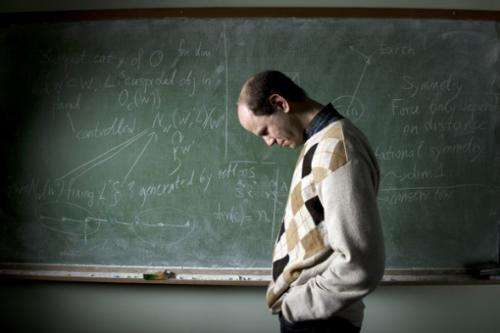Magic and symmetry in mathematics

We live in a three-dimensional world. Despite the many benefits this presents, it also makes for a complicated math problem, according to Northeastern associate professor of mathematics Ivan Loseu. The best a path to a solution, he said, is reducing the number of variables we're dealing with.
Consider the Earth moving around the sun. Three variables are needed to describe the position of the Earth because the motion occurs in this three-dimensional space. Newton's laws in physics allow you to reduce the number of variables even further to two, since the Earth never leaves a certain plane. But, hey, one variable is even better than two. That's why physicists use the properties of gravitational force to track the Earth's elliptical trajectory.
"The formula for gravity depends only on the distance between the sun and Earth," Loseu said. "You rotate the picture, but the physical law remains the same."
The reason this problem can be solved using only one variable, he said, can be described in one word: symmetry.
"A symmetry is any transformation that preserves your problem," Loseu explained. The symmetry people typically imagine involves reflecting an image over a single plane to reveal the exact same image—like looking in a mirror. But that's only one type of symmetry. There are plenty of others. For instance, rotational symmetry describes the fact that rotating an object—say the Earth's orbital pattern—around an axis doesn't change its properties.
Loseu explained that symmetries allow for reducing the dimension of a system because they can be used to produce preserved quantities; in other words, properties that do not change no matter how much the system changes.
This idea of using symmetries to reduce the number of variables is the critical element in Loseu's research toolbox. He uses it not to solve problems in physics, but rather to solve problems in representation theory, a sophisticated branch of algebra. He was recently named a Sloan 2014 Research Fellow for his contributions to this field.
And just as numbers are used in algebra, so too are symmetries.
"Take two symmetrical transformations, apply them consequently, and the composition of the two is again a symmetry," Loseu explained.
The more symmetric a system, he continued, the easier the system is to solve. Therefore, identifying symmetries can help simplify a problem and transform it from an unsolvable one to a solvable one.
This idea serves as the foundation for what he'll be focusing on in the first year of his two-year fellowship, presented by the Alfred P. Sloan Foundation. "If all of this is a tree, I've told you about only its roots," he said, noting that a mole may think it has a full picture of an oak or a maple, but until it pops its head through the soil, its perspective is limited.
Loseu's interest in mathematics took shape in elementary school in Belarus. His parents were engineers whose work revolved around the applied sciences, and he often played with the many math books and calculators he could find around the house. He quickly learned that mathematics was "the thing I loved most of all."
As an undergraduate student at Belarusian State University, Loseu initially thought he would pursue work in applied mathematics, but the field didn't retain the beauty that he appreciated about pure mathematics.
"Any scientific discovery involves some kind of magic," he said. That is, various pieces that may seem to be completely unrelated eventually start to fit together through the fruits of one's labor. "Since pure math is pure, all this magic is much more clearly seen.
Provided by Northeastern University




















